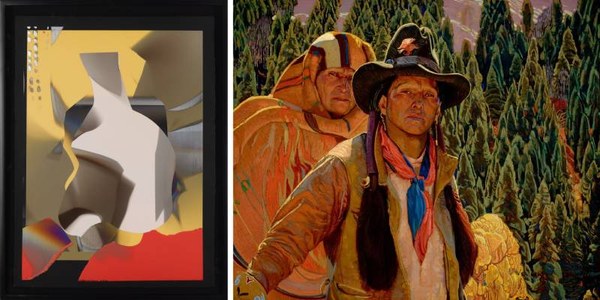Common Ground: Art in New Mexico

Common Ground: Art in New Mexico
Since the arrival of humans more than 13,000 years ago, New Mexico has been a center for artistic production and creativity. Few places in the United States can celebrate such a significant and continuous history of artmaking, from prehistory to the ingenuity of the current moment. Art in New Mexico is characterized by the celebration of tradition, innovation within heritage, and groundbreaking developments of new forms and ideas. People of diverse cultures have lived together and influenced each other throughout the centuries.
Many museums often make sense of this diversity by dividing cultures into more clearly identified groups. However, humans do not always live in easily defined communities. This is especially true in New Mexico. The broad range of the Albuquerque Museum’s permanent collection reflects New Mexican creativity in its many forms.
“Common Ground” presents multiple perspectives and voices exploring the lived experiences, cultures, histories, and art in this region. Artworks are grouped by several guiding questions bringing artists and the diverse ideas, peoples, and places represented into dialogue. These works of art illustrate that as humans, we have more in common with each other than we have differences that divide us. Acknowledging the sometimes violent and complex history of our region, the museum strives to tell the stories that impact how each of us reacts to and experiences the world around us.
New to the Collection
Larry Bell: "To Janet"
A Gift from Janet Webb
In a vacuum chamber in Taos, New Mexico, located 130 miles north of Albuquerque, artist Larry Bell forges complex combinations of gasses, metals, and other natural and synthetic materials through a knowledge of chemistry and physics developed over a lifetime. A novel process that Bell first established in Venice Beach in the 1970s, he begins his compositions by layering materials such as gold, platinum, blood, and Inconel—a nickel-chromium based superalloy known for its ability to withstand extreme environments. When exposed to the sub-atmospheric pressure of a vacuum coating chamber, these materials are vaporized into individual molecules and deposited onto either colored canvases, sheets of paper, or panes of glass. By carefully masking areas of the surface with sheets of Mylar, Bell is able to create works of art that display a wide variety of textures as well as shimmering, iridescent tones.
This collection of Larry Bell artworks is from the estate of Taos-based designer and small business owner Janet Webb (1945–2024). Regarded by many in her community as a tireless advocate for the arts, Janet was also married to Larry for 52 years. The Albuquerque Museum is proud to commemorate five decades of collecting the artist’s work and indebted to the estate of Janet Webb for this generous gift from her personal collection.
A large part of the Albuquerque Museum’s art collection consists of generous donations from artists and members of the community. Impressive and important works are coming into the museum throughout the year. New to the Collection features recent acquisitions of various genres that reflect the museum’s mission to collect artwork that tells the diverse stories of our state and region as well as a broader art history that has been influential or relevant to local artists. The art collection is central to the museum’s responsibility to serve Albuquerque’s communities, create enriching educational opportunities, and preserve important works of art for future generations.
Images:
Larry Bell, SF 6.17.12 Janet, 2012, mixed media on black paper, 30 x 22 in., Albuquerque Museum, bequest of the estate of Janet Webb
Ernest L. Blumenschein, Star Road and White Sun, 1920, oil on canvas, 41 1/2 x 50 1/2 in., Albuquerque Museum, museum purchase 1985 General Obligation Bonds, Albuquerque High School Collection gift of classes 1943, 1944, and 1945
